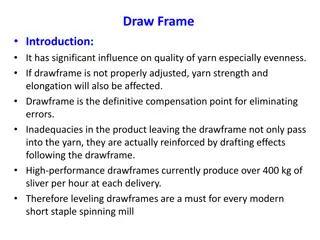How to Draw a Systems Diagram: Step-by-Step Guide for a Simple Example
Identify system components, characterize their behavior, draw linkages, and consider additional details to create a comprehensive systems diagram. Follow basic steps and a simple example of heating a room to understand the process effectively.
Download Presentation

Please find below an Image/Link to download the presentation.
The content on the website is provided AS IS for your information and personal use only. It may not be sold, licensed, or shared on other websites without obtaining consent from the author.If you encounter any issues during the download, it is possible that the publisher has removed the file from their server.
You are allowed to download the files provided on this website for personal or commercial use, subject to the condition that they are used lawfully. All files are the property of their respective owners.
The content on the website is provided AS IS for your information and personal use only. It may not be sold, licensed, or shared on other websites without obtaining consent from the author.
E N D
Presentation Transcript
How to Draw a Systems Diagram Step-by-Step Instructions for a Simple Example
Basic Steps to Follow: 1. Identify components of system: Things Events Measured Value/Data Characterize the behavior of the system components: Are they static? How do they change with time? Sketch graphs! Identify linkages and connections between components. Draw the linkages between system components, indicating feedback loops. As you draw components and connections on the diagram, make sure that you have included all of the relevant components. Add new components and connections as needed. Pay attention to the level of detail you are including is a component or connection too specific for the diagram you are making? 2. 3. 4. 5.
Step 1: Identify Components of the System Components: Heater with on/off switch Room Thermostat (optional) Events: Turning on/off the heater Measured Value: Temperature of the room
Step 2: Characterize the Behavior of the System Components: Components: Heater with on/off switch Room Thermostat Events: Turning on/off the heater Measured Value: Temperature of the room High Temperature Low On Off Heater State T > set point, switch off T < set point, switch on
Steps 3 & 4: Identify and Draw Linkages Between Components (Without Thermostat): Enter Room Heater Switch On Warmed Room High Temperature Low Time
Steps 3 & 4: Identify and Draw Linkages Between Components (With Thermostat): Temperature High Warmed Room Low Time Measure Temperature Heater Switch On Enter Room Thermostat T > set point, turn off T < set point, turn on
Step 5: Consider Where Additional Detail Could Be Added: Flows of heated and cold air into/out of the room. Warmed Room How the heater works (i.e. switch on, current passed through element, fan blows air into room or switch on, burner fired to heat water, water circulated through pipes). Measure Temperature How the thermometer works. Heater Switch On How the thermostat works. Enter Room Thermostat The biological/physiological mechanisms for a person entering a room and sensing the temperature. T > set point, turn off T < set point, turn on
Basic Steps to Follow: 1. Identify components of system: Things Events Measured Value/Data Characterize the behavior of the system components: Are they static? How do they change with time? Sketch graphs! Identify linkages and connections between components. Draw the linkages between system components, indicating feedback loops. As you draw components and connections on the diagram, make sure that you have included all of the relevant components. Add new components and connections as needed. Pay attention to the level of detail you are including is a component or connection too specific for the diagram you are making? 2. 3. 4. 5.























